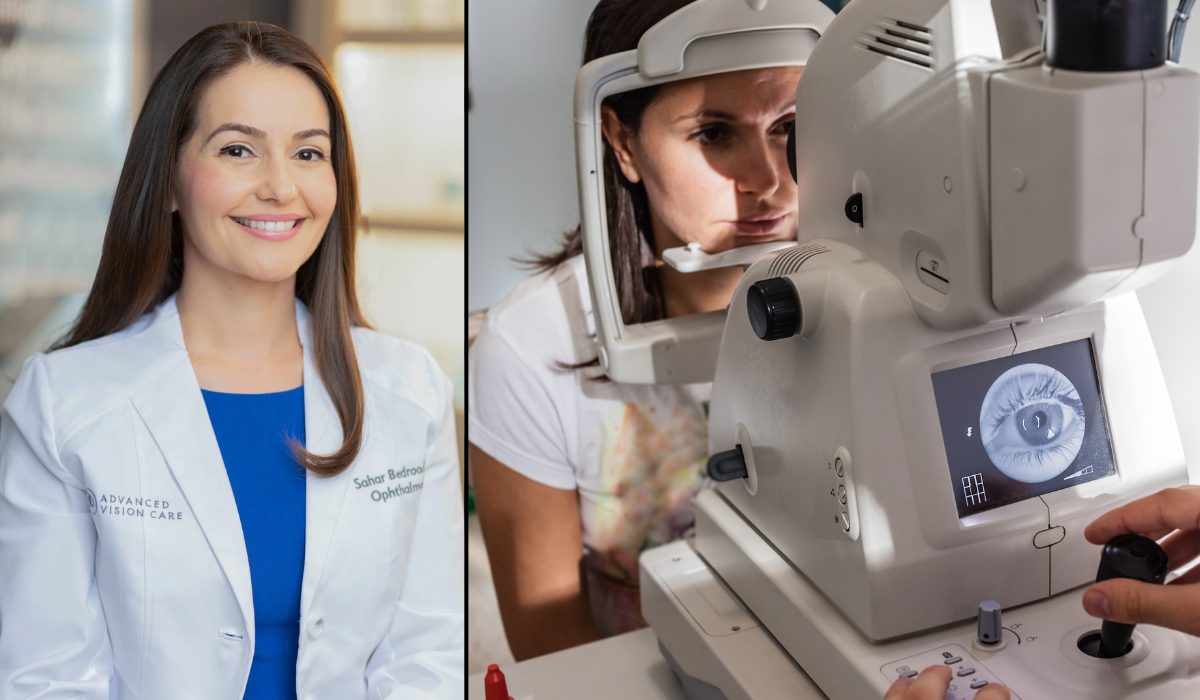How to Protect Your Eyes As You Age

As an ophthalmologist, I often hear patients express concerns that their “eyes are getting old” and that aging and worsening of vision is an inevitable part of life.
While there are a number of eye conditions that are associated with aging, many of them can be reversed, treated, or simply monitored closely for preventative measures.
For Eye Health Awareness Month, I’d like to highlight a few of the most common eye conditions related to aging, along with advice on how to reduce the risk of vision loss or vision changes.
Presbyopia
The most common (and dare I say, guaranteed!) part of aging eyes is the inability to focus on near vision, which is called presbyopia. The eye has a natural lens that accommodates or moves between distance and near throughout our younger years—similar to an autofocus on a camera lens. Sometime in your mid-40s, the fibers that control the movement of that natural lens stiffen and you lose the ability to focus in on near objects and letters. That is when you get the need for reading glasses.
I often reassure patients that this is a “normal” part of aging and even though it can be distressing to someone who has seen very well in the past, there is no reason for concern. A simple pair of reading glasses will fix that problem. A newer option: There are eye drops that can be prescribed by your eye care professional that can be placed in the eyes and help you see near for a few hours while also allowing you to see your normal distance vision.
Cataracts
Cataracts are what we call the clouding and yellowing of our natural lens. When we are born, the natural lens in our eyes is clear. As we age, factors such as genetics and the environment change the lens to become more cloudy. The symptoms of a cataract include decreased vision with glasses on objects or words that were once clear, difficulty with glare, and/or halo with oncoming traffic at night time. The timing of when someone develops a cataract largely depends on genetics. However, environmental factors such as sun exposure and smoking, as well as certain medications (including chronic use of oral steroids) can quicken the onset of cataracts.
The treatment for cataracts has thankfully advanced to include surgery that removes the cataract and replaces it with a lens that is the prescription of the patient, enabling them to see more clearly without the aid of glasses. There are also a number of specialty types of lenses that patients can opt for that can fine tune vision to correct astigmatism and near vision.
Dry eye
This is the most common eye-related complaint in ophthalmology and occurs when your natural tears are not able to adequately lubricate your eye. It affects about 30 percent of the population and can worsen with age.
There are different types of dry eyes; some eyes do not produce enough lubricant (or lipid) in their natural tears while other eyes have their tears evaporate too quickly, leaving the eyes with a feeling of burning, irritation and blurry vision. Reasons for tear film dysfunction include age, changes in hormones, inflammation of the glands that help lubricate the eye, autoimmune disease, environmental dryness, medication use, and poor blink rate.
Treatment for dry eye is life-long and focuses on using artificial tears/nightly lubricants along with drops that reduce the inflammation associated with dry eye. Additionally, patients can increase their water intake, use humidifiers to increase the environmental humidity, apply warm compresses to the eye lids, and use lid wipes to remove daily debris on the eyelashes. There are also a number of eye drops on the horizon to help relieve dry eye in more nuanced ways.
Glaucoma
Glaucoma is a disease where the optic nerve degenerates over time. The optic nerve connects and transmits all the vision from our eyes to our brain. In glaucoma, however, the cells of the nerve start to deteriorate over time and won’t allow the signal from the eyes to be transmitted to the brain. We have not yet learned the true cause of why the cells die over time, but there are a number of risk factors that can contribute to the disease progression. These include age (over 60), high eye pressure, large optic nerves, family history of glaucoma, thin corneas, narrow drainage of the eye, and African, Hispanic or Asian descent. There are different types of glaucoma and some can be caused by trauma, steroid use, and/or complex eye surgeries.
Nearly 4.3 million people in the United States have glaucoma, but about half of them do not know it. Glaucoma is often a silent disease with no symptoms early on and it can lead to complete vision loss if it’s not detected early. As the disease advances, the patient may notice peripheral vision loss. But since the loss can be slow it often goes undetected. Therefore, regular eye exams—especially if there is a family history of glaucoma—is imperative.
However, if someone is diagnosed with glaucoma early in the disease process, the future is still bright. There has been a huge renaissance of treatment modalities, including laser therapy, sustained release (dropless treatment), and minimally invasive surgeries that have been added to the traditional use of drops and traditional surgery. In my own practice, I implement a proactive approach to glaucoma treatment that focuses on early diagnosis and treatment that helps reduce the eye pressure and the risk of vision loss.
Macular degeneration
Age-related Macular degeneration (AMD) is the leading cause of disease in people over the age of 50. The risk factors for AMD include being over age 50, family history of AMD, a diet high in saturated fat, and a history of smoking.
The macula is the central part of the retina which is responsible for all the central vision as well as the color vision of the eye. It is thought that small deposits of drusen can disrupt the retina and cause leakage of blood vessels and damage to the cells of the retina responsible for central vision. There are two types of AMD: dry AMD and wet AMD. The treatment for AMD depends on the type and can include treatment with a drug called an anti-VEGF, which reduces the abnormal blood vessels and the leakage associated with the disease.
Interestingly, there are preventive measures a patient can take. A large study called the AREDS 2 trial found that the use of a certain formula of antioxidants and vitamins can prevent or slow down the disease process. The AREDS 2 formula is sold over the counter and includes the following:
· Vitamin C (500 mg)
· Vitamin E (400 IU)
· Lutein (10 mg)
· Zeaxanthin (2 mg)
· Zinc (80 mg)
· Copper (2 mg)
The treatment for macular degeneration is also full of advancements, therefore a thorough exam and discussion with your ophthalmologist or retina specialist would provide the most accurate treatment for your type of macular degeneration.
While age is certainly a risk factor for a number of eye diseases, there are so many treatment modalities and preventative measures that makes ageing more hopeful in the face of eye health. Having a discussion with your eye care professional or ophthalmologist is a good place to start.
Dr. Sahar Bedrood is a board-certified, fellowship-trained ophthalmologist specializing in glaucoma and cataract surgery. She currently is in private practice at Advanced Vision Care in Los Angeles, CA.
Please note that we may receive affiliate commissions from the sales of linked products.



